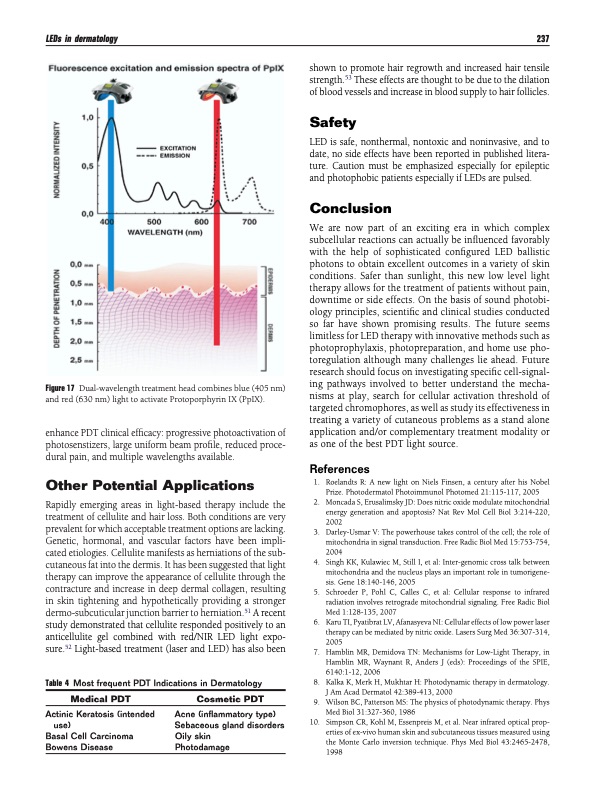
PDF Publication Title:
Text from PDF Page: 011
LEDs in dermatology 237 Figure17 Dual-wavelengthtreatmentheadcombinesblue(405nm) and red (630 nm) light to activate Protoporphyrin IX (PpIX). enhance PDT clinical efficacy: progressive photoactivation of photosenstizers, large uniform beam profile, reduced proce- dural pain, and multiple wavelengths available. Other Potential Applications Rapidly emerging areas in light-based therapy include the treatment of cellulite and hair loss. Both conditions are very prevalent for which acceptable treatment options are lacking. Genetic, hormonal, and vascular factors have been impli- cated etiologies. Cellulite manifests as herniations of the sub- cutaneous fat into the dermis. It has been suggested that light therapy can improve the appearance of cellulite through the contracture and increase in deep dermal collagen, resulting in skin tightening and hypothetically providing a stronger dermo-subcuticular junction barrier to herniation.51 A recent study demonstrated that cellulite responded positively to an anticellulite gel combined with red/NIR LED light expo- sure.52 Light-based treatment (laser and LED) has also been Table 4 Most frequent PDT Indications in Dermatology shown to promote hair regrowth and increased hair tensile strength.53 These effects are thought to be due to the dilation of blood vessels and increase in blood supply to hair follicles. Safety LED is safe, nonthermal, nontoxic and noninvasive, and to date, no side effects have been reported in published litera- ture. Caution must be emphasized especially for epileptic and photophobic patients especially if LEDs are pulsed. Conclusion We are now part of an exciting era in which complex subcellular reactions can actually be influenced favorably with the help of sophisticated configured LED ballistic photons to obtain excellent outcomes in a variety of skin conditions. Safer than sunlight, this new low level light therapy allows for the treatment of patients without pain, downtime or side effects. On the basis of sound photobi- ology principles, scientific and clinical studies conducted so far have shown promising results. The future seems limitless for LED therapy with innovative methods such as photoprophylaxis, photopreparation, and home use pho- toregulation although many challenges lie ahead. Future research should focus on investigating specific cell-signal- ing pathways involved to better understand the mecha- nisms at play, search for cellular activation threshold of targeted chromophores, as well as study its effectiveness in treating a variety of cutaneous problems as a stand alone application and/or complementary treatment modality or as one of the best PDT light source. References 1. Roelandts R: A new light on Niels Finsen, a century after his Nobel Prize. Photodermatol Photoimmunol Photomed 21:115-117, 2005 2. Moncada S, Erusalimsky JD: Does nitric oxide modulate mitochondrial energy generation and apoptosis? Nat Rev Mol Cell Biol 3:214-220, 2002 3. Darley-Usmar V: The powerhouse takes control of the cell; the role of mitochondria in signal transduction. Free Radic Biol Med 15:753-754, 2004 4. Singh KK, Kulawiec M, Still I, et al: Inter-genomic cross talk between mitochondria and the nucleus plays an important role in tumorigene- sis. Gene 18:140-146, 2005 5. Schroeder P, Pohl C, Calles C, et al: Cellular response to infrared radiation involves retrograde mitochondrial signaling. Free Radic Biol Med 1:128-135, 2007 6. Karu TI, Pyatibrat LV, Afanasyeva NI: Cellular effects of low power laser therapy can be mediated by nitric oxide. Lasers Surg Med 36:307-314, 2005 7. Hamblin MR, Demidova TN: Mechanisms for Low-Light Therapy, in Hamblin MR, Waynant R, Anders J (eds): Proceedings of the SPIE, 6140:1-12, 2006 8. Kalka K, Merk H, Mukhtar H: Photodynamic therapy in dermatology. J Am Acad Dermatol 42:389-413, 2000 9. Wilson BC, Patterson MS: The physics of photodynamic therapy. Phys Med Biol 31:327-360, 1986 10. Simpson CR, Kohl M, Essenpreis M, et al. Near infrared optical prop- erties of ex-vivo human skin and subcutaneous tissues measured using the Monte Carlo inversion technique. Phys Med Biol 43:2465-2478, 1998 Medical PDT Actinic Keratosis (intended use) Basal Cell Carcinoma Bowens Disease Cosmetic PDT Acne (inflammatory type) Sebaceous gland disorders Oily skin PhotodamagePDF Image | (LEDs) in Dermatology

PDF Search Title:
(LEDs) in DermatologyOriginal File Name Searched:
vol27_i4_Light-Emitting_Diodes.pdfDIY PDF Search: Google It | Yahoo | Bing
Cruise Ship Reviews | Luxury Resort | Jet | Yacht | and Travel Tech More Info
Cruising Review Topics and Articles More Info
Software based on Filemaker for the travel industry More Info
The Burgenstock Resort: Reviews on CruisingReview website... More Info
Resort Reviews: World Class resorts... More Info
The Riffelalp Resort: Reviews on CruisingReview website... More Info
| CONTACT TEL: 608-238-6001 Email: greg@cruisingreview.com | RSS | AMP |